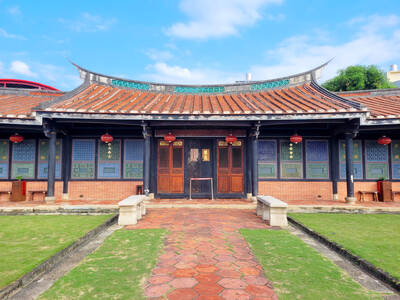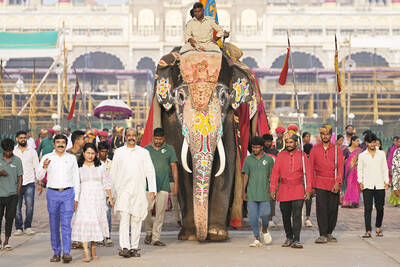A new exhibition just opened by Lebanese artist Randa Ali Ahmed would, at first glance, seem to be a fitting testament to the end of the global economic boom: the bare cement walls of a bombed-out looking Beirut gallery adorned by acrylic-on-canvas depictions of suited businessmen in varying states of dejection and despair.
Euphoria, the exhibition by Ali Ahmed that opened on Dec. 11 at the Phoenix Gallery in Beirut, offers a journey into the extremes of emotion that many of the world’s executives — and, by extension, ordinary people too — have felt since the economic crisis began spreading around the globe this year.
Some of the panels offer a close-up of the male-dominated business world in meltdown — in Ali Ahmed’s distinctive stylized idiom: they could be traders on the trading floor after a heavy loss; or property moguls watching their asset values fall through the floor.
Others, however, point out of the maelstrom and toward what comes next: recovery, growth, and renewal.
“I wanted in my exhibition to show that positive things can come after such a crisis,” Ali Ahmed said.
“I ended the theme with a painting of a man smiling, reflecting on the positive mood that will come after this dark cloud melts away,” she said.
Beirut has long been one of the Middle East’s trading entrepots, and in recent years has been a favorite target for investment of the petrodollars flowing from the Gulf Arab states, particularly in real estate and commerce.
With oil prices a fraction of their level at the beginning of the year, the tide of Gulf oil money that has so buoyed economies across the region has begun to recede. Lebanon will undoubtedly feel the pinch.
Ali Ahmed stresses that her artistic mission is not to find solutions to these problems, but to imagine how people can be positive in order to retain the belief that solving them is even possible.
“I just hope that people who will visit my exhibition will see the positive atmosphere I am trying to show through my paintings,” she says, adding that this theme is borne out by the development of the panels from despair to hope.
“That is why I displayed them in order, as a story, and ended with the last picture of a man with hope for the future,” she said.
Crestfallen executive guests at the nearby Intercontinental Phonecia hotel will be glad to know that the exhibition runs until next Tuesday.

Last week saw the appearance of another odious screed full of lies from the People’s Republic of China (PRC) Ambassador to Australia, Xiao Qian (肖千), in the Financial Review, a major Australian paper. Xiao’s piece was presented without challenge or caveat. His “Seven truths on why Taiwan always will be China’s” presented a “greatest hits” of the litany of PRC falsehoods. This includes: Taiwan’s indigenous peoples were descended from the people of China 30,000 years ago; a “Chinese” imperial government administrated Taiwan in the 14th century; Koxinga, also known as Cheng Cheng-kung (鄭成功), “recovered” Taiwan for China; the Qing owned

When 17-year-old Lin Shih (林石) crossed the Taiwan Strait in 1746 with a group of settlers, he could hardly have known the magnitude of wealth and influence his family would later amass on the island, or that one day tourists would be walking through the home of his descendants in central Taiwan. He might also have been surprised to see the family home located in Wufeng District (霧峰) of Taichung, as Lin initially settled further north in what is now Dali District (大里). However, after the Qing executed him for his alleged participation in the Lin Shuang-Wen Rebellion (林爽文事件), his grandsons were

I am kneeling quite awkwardly on a cushion in a yoga studio in London’s Shoreditch on an unseasonably chilly Wednesday and wondering when exactly will be the optimum time to rearrange my legs. I have an ice-cold mango and passion fruit kombucha beside me and an agonising case of pins and needles. The solution to pins and needles, I learned a few years ago, is to directly confront the agony: pull your legs out from underneath you, bend your toes up as high as they can reach, and yes, it will hurt far more initially, but then the pain subsides.

A jumbo operation is moving 20 elephants across the breadth of India to the mammoth private zoo set up by the son of Asia’s richest man, adjoining a sprawling oil refinery. The elephants have been “freed from the exploitative logging industry,” according to the Vantara Animal Rescue Centre, run by Anant Ambani, son of the billionaire head of Reliance Industries Mukesh Ambani, a close ally of Prime Minister Narendra Modi. The sheer scale of the self-declared “world’s biggest wild animal rescue center” has raised eyebrows — including more than 50 bears, 160 tigers, 200 lions, 250 leopards and 900 crocodiles, according to